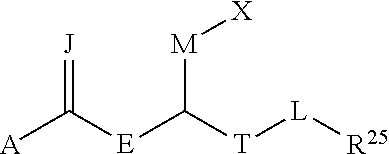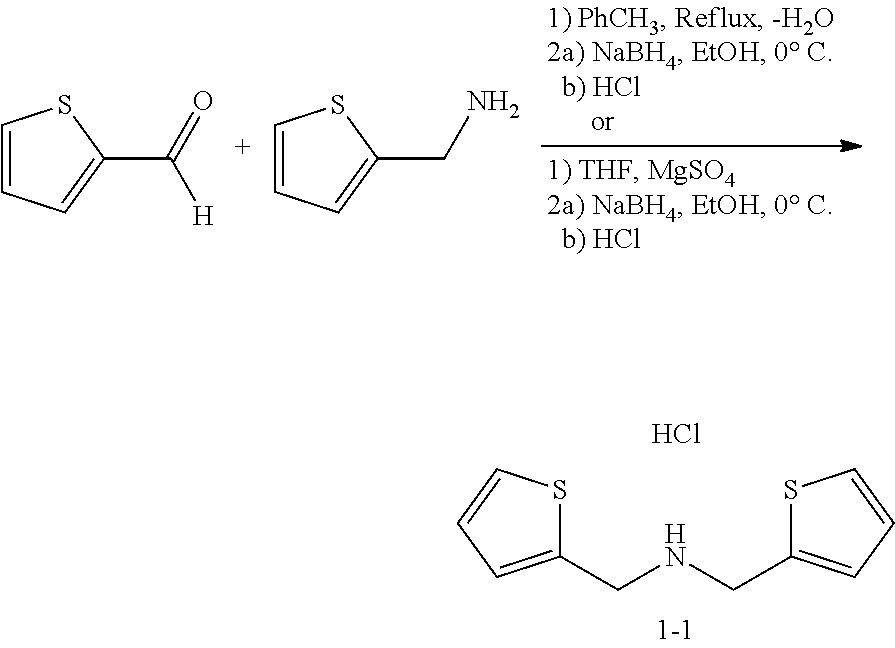Agonists that enhance binding of integrin-expressing cells to integrin receptors
a technology of integrin receptors and agonists, which is applied in the field of integrin agonists, can solve problems such as defective or decreased organ function, and achieve the effect of enhancing the integrin-mediated binding of cells
- Summary
- Abstract
- Description
- Claims
- Application Information
AI Technical Summary
Benefits of technology
Problems solved by technology
Method used
Image
Examples
example 1
Preparation of 1-(2-thienyl)-N-(2-thienylmethyl)methanamine hydrochloride (1-1)
[0240]
I. Method A
[0241]To a solution of 2-thiophenemethylamine (3.87 g, 34.5 mmol) in toluene (69 mL), 2-thiophenecarboxaldehyde (3.90 g, 34.5 mmol) was added. The resulting solution was heated at vigorous reflux for 1.75 hours while removing the water formed by means of a Dean-Stark trap. The resulting mixture was cooled to room temperature and concentrated under reduced pressure. The residue was dissolved in anhydrous ethanol (69 mL), the mixture was cooled to 0° C., and sodium borohydride (2.71 g, 69 mmol) was added in portions over the course of 30 minutes. The mixture was allowed to warm to room temperature overnight, was poured over ice, and acidified slowly with aqueous hydrochloric acid (2N). The precipitate was filtered and dried under vacuum to give the title compound 1-1 as an off-white to tan solid (5.35 g).
[0242]Alternately, the starting free amine could be generated from the amine hydrochlor...
example 2
Preparation of 1-(3-methoxyphenyl)-N-(2-thienylmethyl)methanamine hydrochloride (1-2)
[0246]
[0247]To a solution of 3-methoxybenzylamine (1.37 g, 9.99 mmol) and 2-thiophenecarboxaldehyde (1.12 g, 10.0 mmol) in toluene (10 mL), anhydrous magnesium sulfate (2 g) was added. The mixture was allowed to stand overnight at room temperature and sodium borohydride (0.5 g, 13 mmol) was added followed by ethanol (10 mL). The resulting mixture was stirred for 3 hours and acidified with aqueous hydrochloric acid (2N). The resulting precipitate was filtered and dried under vacuum to give the title compound 1-2 as a white solid (1.19 g).
[0248]This procedure was also used to prepare: N-(3-methoxybenzyl)-1-(3-methoxyphenyl)methanamine hydrochloride (1-3) from 3-methoxybenzylamine and 3-methoxybenzaldehyde; and 2-(2-thienyl)-N-(2-thienylmethyl)ethanamine hydrochloride (1-5) from 2-thiopheneethylamine and 2-thiophenecarboxaldehyde.
[0249]Alternately, tetrahydrofuran could be used in place of toluene. Thi...
example 3
Preparation of 4-{[(2-thienylmethyl)amino]methyl}phenol hydrochloride (1-14)
[0253]
[0254]A solution of 4-hydroxybenzaldehyde (0.65 g, 5.2 mmol) and 2-thiophenemethylamine (0.59 g, 5.3 mmol) in toluene (25 mL) was heated at vigorous reflux for 4 hours while removing the water formed by means of a Dean-Stark trap. The resulting mixture was cooled to room temperature, sodium borohydride (excess) and ethanol (excess) were added, and the mixture was stirred overnight. The mixture was acidified with aqueous hydrochloric acid (2N) and warmed gently until gas evolution ceased. The solution was adjusted to pH 6-7 and extracted with dichloromethane (3 times). The organic layers were combined, washed with brine, dried, filtered and concentrated under reduced pressure to give the title compound 1-14 as an orange oil (0.44 g).
Example 14
Preparation of methyl(3S)-3-(1,3-benzodioxol-5-yl)-3-{[(4-nitrophenoxy)carbonyl]amino}propanoate (1-19)
[0255]
I. Methyl(2E)-3-(1,3-benzodioxol-5-yl)acrylate (1-16)
[...
PUM
| Property | Measurement | Unit |
|---|---|---|
| temperature | aaaaa | aaaaa |
| temperature | aaaaa | aaaaa |
| temperature | aaaaa | aaaaa |
Abstract
Description
Claims
Application Information
 Login to View More
Login to View More - R&D
- Intellectual Property
- Life Sciences
- Materials
- Tech Scout
- Unparalleled Data Quality
- Higher Quality Content
- 60% Fewer Hallucinations
Browse by: Latest US Patents, China's latest patents, Technical Efficacy Thesaurus, Application Domain, Technology Topic, Popular Technical Reports.
© 2025 PatSnap. All rights reserved.Legal|Privacy policy|Modern Slavery Act Transparency Statement|Sitemap|About US| Contact US: help@patsnap.com



